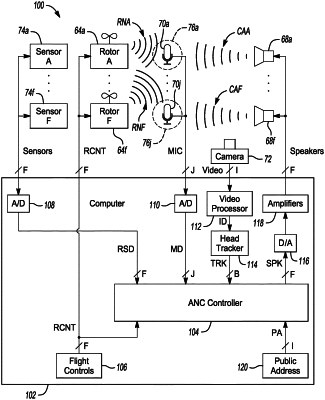| CPC G10K 11/17881 (2018.01) [G06F 3/012 (2013.01); G06V 20/593 (2022.01); G10K 11/17823 (2018.01); G10K 11/17854 (2018.01); G10K 11/17857 (2018.01); G10K 11/17883 (2018.01); H04R 3/005 (2013.01); H04R 3/12 (2013.01); G10K 2210/121 (2013.01); G10K 2210/1281 (2013.01); G10K 2210/3046 (2013.01); H04R 2499/13 (2013.01)] | 17 Claims |

|
9. A method for cancelling sounds within a vehicle, the method comprising:
generating a plurality of microphone signals representative of a plurality of noise sounds and a plurality of cancellation audio sounds adjacent to a plurality of occupant locations within the vehicle;
generating a video signal that captures one or more head configurations of one or more occupants at the plurality of occupant locations;
receiving a plurality of rotor control signals at a controller from a flight control system of the vehicle;
calculating a plurality of hearing locations of the one or more occupants based on tracking data of the one or more head configurations in response to the video signal;
generating a plurality of speaker signals based on the plurality of hearing locations, the plurality of microphone signals, and the plurality of rotor control signals; and
generating the plurality of cancellation audio sounds in response to the plurality of speaker signals, wherein the plurality of cancellation audio sounds attenuates the plurality of noise sounds at the plurality of hearing locations; wherein
each of the one or more head configurations comprises a respective spatial head location and a respective spatial head orientation, and the method further comprises:
determining either a single closest microphone or two closest microphones among a plurality of microphones for each of the plurality of hearing locations based on the respective spatial head location and the respective spatial head orientation.
|